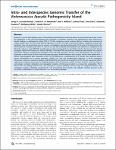Intra- and Interspecies Genomic Transfer of the Enterococcus faecalis Pathogenicity Island
Gomez, Jenny A. Laverde
Hendrickx, Antoni P. A.
Willems, Rob J.
Top, Janetta
Sava, Irina
Huebner, Johannes
Witte, Wolfgang
Werner, Guido
Enterococci are the third leading cause of hospital associated infections and have gained increased importance due to their fast adaptation to the clinical environment by acquisition of antibiotic resistance and pathogenicity traits. Enterococcus faecalis harbours a pathogenicity island (PAI) of 153 kb containing several virulence factors including the enterococcal surface protein (esp). Until now only internal fragments of the PAI or larger chromosomal regions containing it have been transfered. Here we demonstrate precise excision, circularization and horizontal transfer of the entire PAI element from the chromosome of E. faecalis strain UW3114. This PAI (ca. 200 kb) contained some deletions and insertions as compared to the PAI of the reference strain MMH594, transferred precisely and integrated site-specifically into the chromosome of E. faecalis (intergenic region) and Enterococcus faecium (tRNAlys). The internal PAI structure was maintained after transfer. We assessed phenotypic changes accompanying acquisition of the PAI and expression of some of its determinants. The esp gene is expressed on the surface of donor and both transconjugants. Biofilm formation and cytolytic activity were enhanced in E. faecalis transconjugants after acquisition of the PAI. No differences in pathogenicity of E. faecalis were detected using a mouse bacteraemia and a mouse peritonitis models (tail vein and intraperitoneal injection). A 66 kb conjugative pheromone-responsive plasmid encoding erm(B) (pLG2) that was transferred in parallel with the PAI was sequenced. pLG2 is a pheromone responsive plasmid that probably promotes the PAI horizontal transfer, encodes antibiotic resistance features and contains complete replication and conjugation modules of enterococcal origin in a mosaic-like composition. The E. faecalis PAI can undergo precise intra- and interspecies transfer probably with the help of conjugative elements like conjugative resistance plasmids, supporting the role of horizontal gene transfer and antibiotic selective pressure in the successful establishment of certain enterococci as nosocomial pathogens.
No license information

